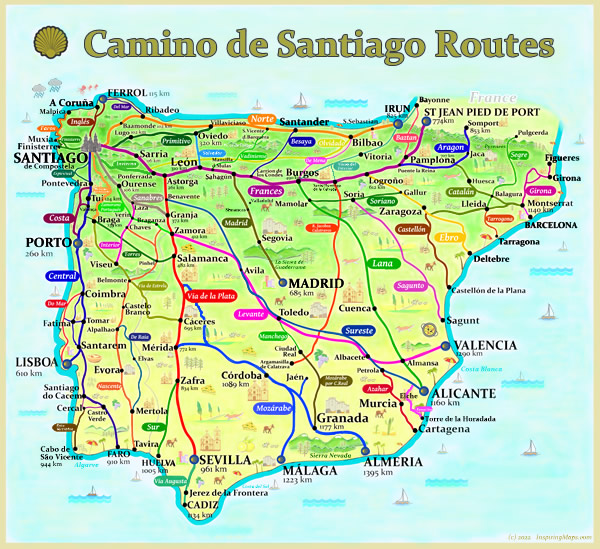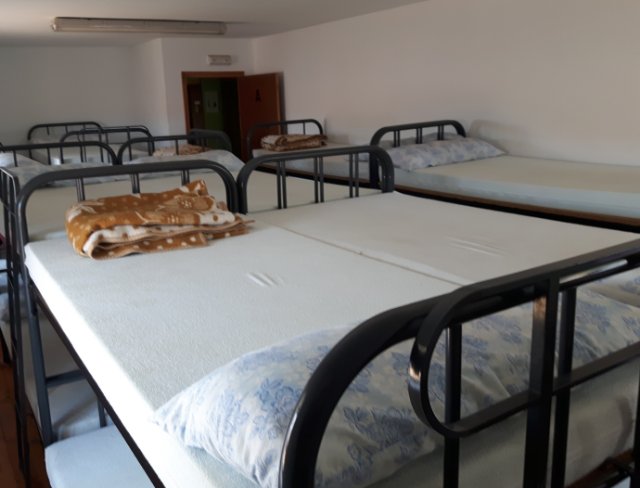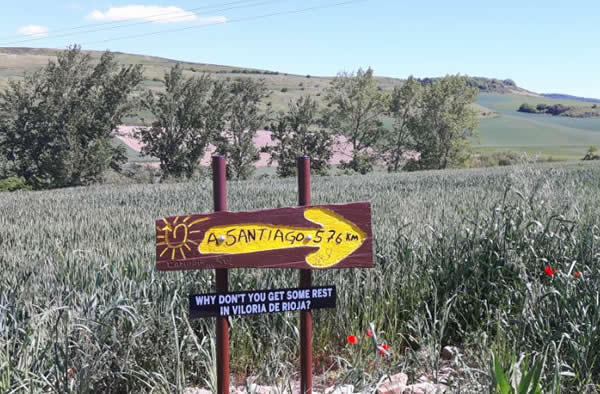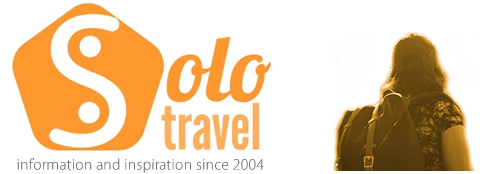Camino de Santiago Solo
The Camino de Santiago, as most people know it is actually one of a number of caminos (see the map below!) that all end up in the Spanish city of Santiago de Compostela, in the northwest of the country.
This article refers to the most popular Camino known as the Camino Frances which, as the name suggest, starts over the border in Southwest France.

Camino Map courtesy of Inspiring Maps
There are many good guides to the Camino which some are listed at the end of the of this article but we are going to look at doing this great journey from a solo perspective.
Here’s the thing, no one will ever really be doing the Camino solo. Ten of thousands of pilgrims now start out on the journey, many of which are alone when they begin. The movie ‘The Way’ has certainly added to the hype and has contributed to a much larger international selection of pilgrims with the United States leading the way.
Planning your Camino de Santiago
Depending on your own way of doing things some people will need little planning for the Camino. The main issue is when to do it and what to take.
Travel Insurance?
Make sure you have adequate Camino Travel Insurance to cover your entire trip. Spanish hospitals are very good, but very expensive too if you don’t have cover!
August is the busiest month, but you should always find accommodation in albergues, which are big hostels that cater only for pilgrims, and expect to pay up to EUR 10 per night for a bed in a dormitory.
Be aware that holy years can up the numbers considerably!

The closer you get to Santiago the more busy the way becomes and this can lead to a mad daily dash to the best albergues but there will always be a bed or floor space somewhere!
Best months to walk the Camino?
So the main consideration when planning on when to do the walk is probably the weather. The best months would be May, June and September. During this period the days are still warm, or sometimes hot but the crowds are less than July and August and walking conditions more bearable.

Some hardy souls will start off in winter but expect very changeable weather and less facilities open.
What should you take on your Camino?
The main aspect of planning is what to take. Our advice is as little as possible. Do not carry tents and camping gear as you will always find a bed. Take only lightweight clothing that dries quickly.
The aim is to only carry 10% of your body weight, and this includes the backpack itself and the annoyingly heavy water.
Plan on having at least one liter on you.

Camino de Santiago Passport
The only other important thing is to have you Pilgrims passport, a document called the credencial, purchased for a few euros from many outlets on the way itself, you can purchase one at the beginning in Saint-Jean Pied de Port or just over the border in Spain.
This document will enable you to stay in alburgues along the way and will be proof once you arrive in Santiago for your certificate. The last 100kms of the Way must have been walked to get this. You can get you passport stamped at many hotels, all albergues and even gas stations!

Your typical day on ‘The Way’
Day’s will usually start very early, indeed some pilgrims will be packing up their stuff from 5am in order to get away early. While this doesn’t make for a relaxing time it does mean you will often avoid the heat of the afternoon as you will arrive at your next destination around lunchtime.
Most days are around 25kms on average but there are places to stay pretty much everywhere and if you want you could probably only walk 5-10kms (4 to 6 miles) a day if you wanted and maybe build up slowly to longer days. It will depend on how long you have and how far you want to go.

Once you have checked in to your accommodation for the day then you will probably sit around and chat to other pilgrims, wash your clothes, repair the blisters on your feet (yes you will get them!) or just chill out with a good book in the sun.
Dinner is usually a communal dining experience and adds to the social nature of the walk. Most Albergues have a strict curfew and will slam the front door shut by 10pm and most people are usually fast asleep soon after!

The ultimate social solo travel experience?
There can be few outdoor activities that you start on your own and meet so many people in the world of travel. From our observations about 50% of the pilgrims are Spanish and they tend to be in preformed groups of friends whereas the international element tends to be walking alone to begin with.
Many people end up walking in a group or in pairs with people they have met on the way. Some people prefer to do the walk alone preferring to set their own pace but enjoying the sociable nature of the evenings in the Albergues.
So here is the thing, the Camino can be as sociable as you want. You could choose to walk alone all day and then stay in a hotel room, in fact after a few days in the busy hostels this can come as a nice treat for one night!
We certainly recommend the Camino because it is just so flexible.
– You can walk as far as you want
– You can start where you want
– You can walk with others or alone
– You have total flexibility where you stay and where you eat
If you are travelling around Europe alone and enjoy walking then the Camino offers a great opportunity to meet folk, young and old, from around the world.
You also will get a magical insight into Spanish culture and rural/city life of Northern Spain.
Buen Camino!

Further reading
